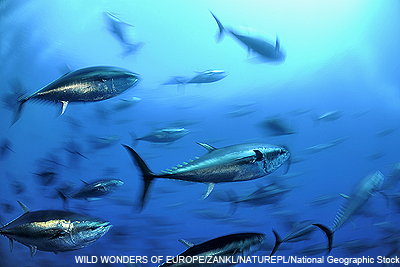Tracking Tuna in the Cloud
Several months ago, I wrote about a study showing that Atlantic bluefin tuna were being caught at a rate much higher than scientists recommended and regulations allowed. Furthermore, fishermen were not reporting their catches to the International Commission for the Conservation of Atlantic Tunas (ICCAT), the body that manages tuna in the Atlantic Ocean. This underreporting undermines measures designed to rebuild bluefin populations and threatens the species' recovery.

A properly designed and implemented electronic tracking program will be more efficient and easier to use, will improve the data collected, and help deter illegal fishing. Accurate information is critical to ensuring that bluefin tuna are managed properly.
A well-designed eBCD, along with science-based catch limits and enforceable regulations, can help guarantee the long-term survival of these magnificent fish.- Lee Crockett, director of U.S. Ocean Conservation
The end of January marked the first deadline for the eBCD project—the invitation for companies to bid for the job of creating the new system. After ICCAT government representatives met in Madrid to develop a request for proposal, this document was released eight days ahead of schedule and contained a list of important requirements. ICCAT and its members should be congratulated for taking the first steps toward establishing a program that could become the standard for counting and tracking tuna caught in fisheries around the world.
This high-tech program will allow Atlantic bluefin fishermen, tuna ranchers, and traders to digitally record the required data for each fish, including but not limited to its size and when, where, and how it was caught. This information would be stored in a “cloud,” an online database that will allow designated authorities from each country to access real-time statistics on bluefin catches and transfers. Officials would then validate the information before the tuna could continue through the supply chain.
The system would also automatically detect when vessels exceeded their annual catch limits and prevent such stocks from legally entering the marketplace by denying the acceptance of records where numbers did not add up properly. Eventually, the eBCD could include a bar code assigned to each fish, which would make tracking this valuable species even easier.
If things go according to schedule, the eBCD program should be designed and ready for testing through a pilot program by the middle of this year. It will then be rolled out fishery-wide in time for the 2013 fishing season, which begins in May.
It is critical ICCAT continues to meet its deadlines and put a system in place to drastically reduce the number of illegally caught bluefin entering the market. The future health of Atlantic bluefin tuna populations will be enhanced by improving the ability to track the amount of fish caught each year. A well-designed eBCD, along with science-based catch limits and enforceable regulations, can help guarantee the long-term survival of these magnificent fish.
This article originally ran at HuffingtonPost.com.











